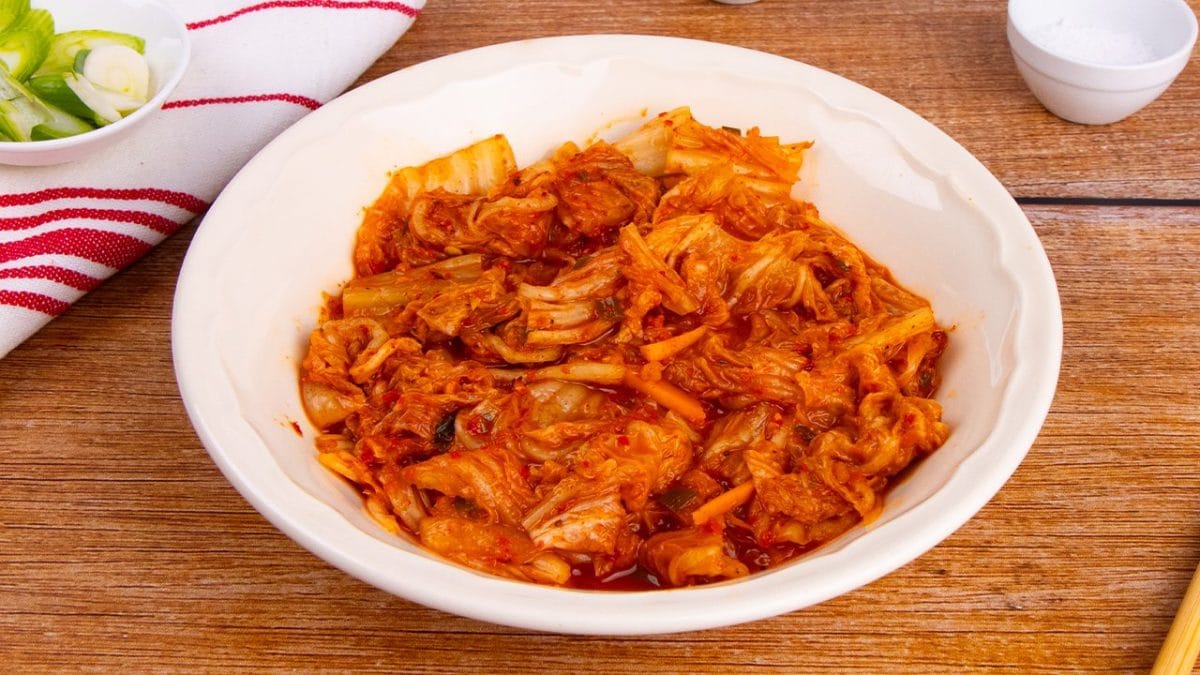
Kimchi is a beloved traditional Korean dish made from fermented napa cabbage and radish, seasoned with garlic, ginger, and chili flakes. Known for its bold flavor and remarkable health benefits, kimchi is perfect for anyone who enjoys tangy, spicy condiments. It's often served as a side dish but also shines in soups, stews, and fried rice.
Why Everyone Will Love This Recipe
This homemade kimchi recipe is vibrant, authentic, and packed with umami.
- Flavor-packed: Bold, spicy, sour, and slightly sweet all at once.
- Gut-friendly: Thanks to natural fermentation, it’s loaded with probiotics.
- Versatile: Serve it as a side dish or incorporate it into your favorite meals.
- Make-ahead: Prepped once, enjoyed for weeks!
What Is Kimchi?
Kimchi is Korea’s most iconic fermented dish, traditionally made with salted cabbage, Korean radish (mu or daikon), and a rich blend of aromatics like garlic, ginger, and red chili flakes. Its roots trace back thousands of years, evolving through time with regional variations and seasonal ingredients. Today, it stands as a staple in Korean households and a global symbol of Korean cuisine—comforting, spicy, and powerfully flavorful.
Cooking Tips for the Best Kimchi
- Use kosher salt (not iodized) to avoid bitterness and ensure even brining.
- Rinse thoroughly after salting to prevent overly salty kimchi.
- Let it ferment at room temperature for 1 to 3 days, depending on your preferred sourness level.
- Wear gloves when spreading the paste to avoid chili burns.
- Use clean jars to prevent contamination and unwanted bacteria during fermentation.
Frequently Asked Questions
What Type of Cabbage Is Best for Kimchi?
Traditional kimchi is made with napa (Chinese) cabbage, which has soft, crinkly leaves that absorb the seasoning well.
Can I Make Kimchi Without Fish Sauce?
Yes! You can substitute with soy sauce or miso paste for a vegan version, though the flavor will be slightly different.
How Spicy Is Kimchi?
It depends on the amount and type of chili flakes used. This recipe is medium-spicy, but you can reduce the red pepper flakes for a milder version.
Is Kimchi Healthy?
Absolutely. It's rich in vitamins, antioxidants, and gut-friendly probiotics due to fermentation.
How Long Should Kimchi Ferment?
Usually 2 to 3 days at room temperature, then transfer to the fridge where it will continue fermenting slowly. It gets more sour over time.
What Can I Use Kimchi In?
Kimchi can be eaten on its own or added to fried rice, soups, pancakes, or ramen for extra depth and spice.
How to Store Kimchi
After fermenting for 2 to 3 days, place the kimchi into clean, airtight jars and store them in the refrigerator.
- Shelf life: Up to 3 months in the fridge.
Tip: Use clean utensils when scooping out kimchi to avoid introducing bacteria. The flavor intensifies over time—some even prefer it at the 1-month mark!
How to Freeze Kimchi
While kimchi is best enjoyed fresh or fermented, you can freeze it to extend its shelf life. Before freezing, pack it into airtight, freezer-safe containers. Frozen kimchi can last up to 3 months. Thaw in the refrigerator before use, and note the texture may be slightly softer.
Ingredients
How to Make Traditional Korean Kimchi

Cut the cabbage lengthwise in half. Make a slit near the base of each half, stopping about 2 inches from the stem to keep leaves attached.

Sprinkle kosher salt between the leaves of each half, gently separating them to distribute the salt evenly. Let sit for 2 hours, flipping occasionally. Rinse the cabbage halves under cold water 2–3 times to remove excess salt. Drain well.

In a saucepan, combine water, rice flour, and brown sugar. Stir over low heat until thickened into a smooth porridge. Let it cool completely.

In a food processor, blend onion, garlic, and ginger until finely chopped.

Julienne or shred the daikon, carrot, green onions, and chives.

In a large bowl, mix the cooled porridge, blended aromatics, fish sauce, fermented shrimp, and red pepper flakes. Add chopped vegetables and mix until well combined.

Wearing gloves, rub the seasoning paste between each cabbage leaf, making sure every part is coated.
Place the coated cabbage halves into a large container. Cover loosely with plastic wrap or lid and let sit at room temperature for 2–3 days.

After fermenting, cut into smaller pieces and transfer to clean jars. Store in the fridge and enjoy!

;Resize,width=767;)
